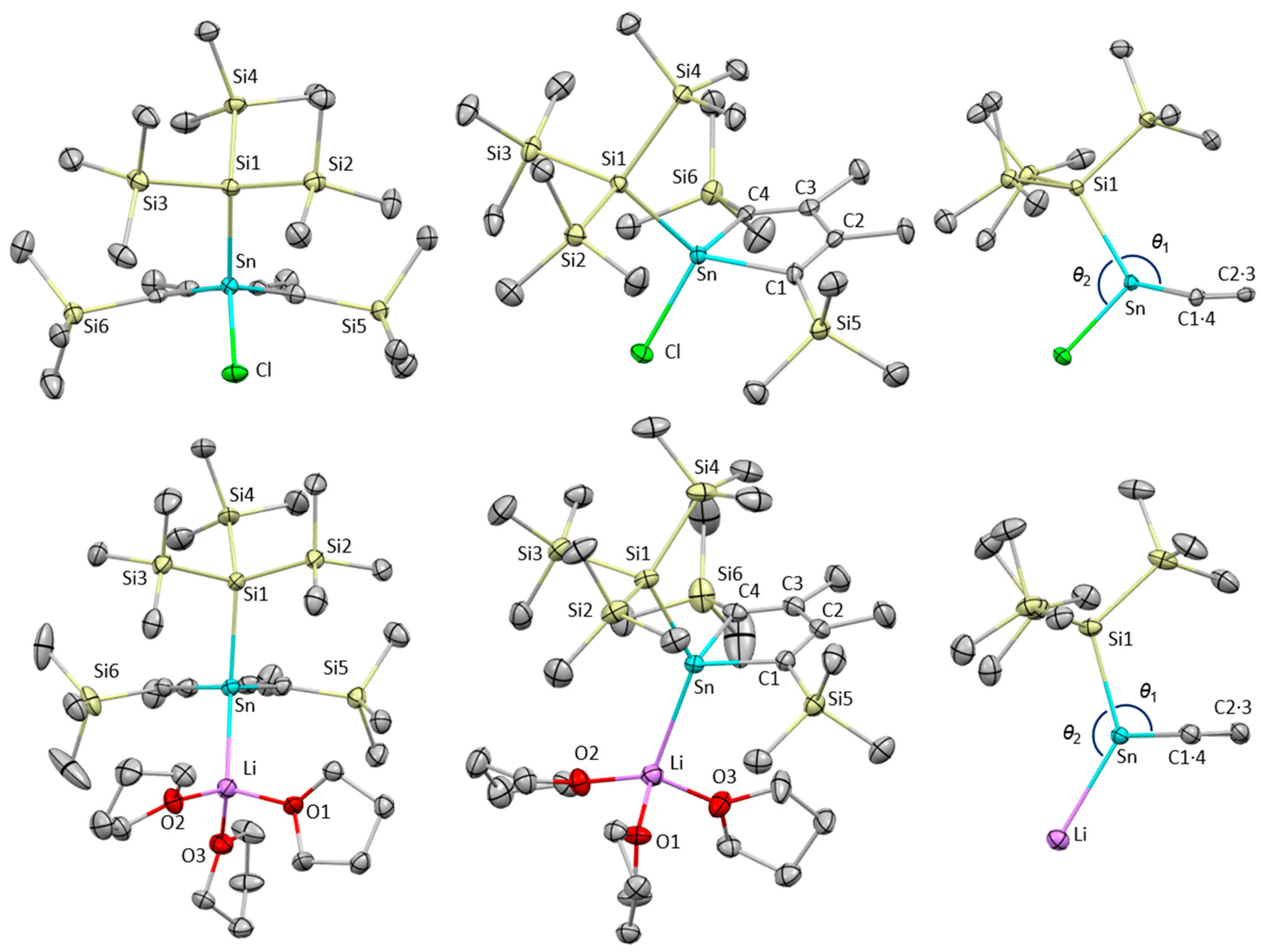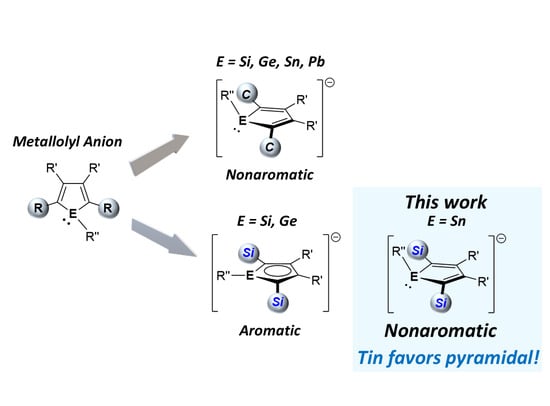Lithium Salt of 2,5-Bis(trimethylsilyl)stannolyl Anion: Synthesis, Structure, and Nonaromatic Character
Abstract
1. Introduction
2. Results and Discussion
3. Materials and Methods
3.1. General Considerations
3.2. Synthesis of 1,1-Dichloro-2,5-trimethylsilyl-3,4-dimethylstannole 1
3.3. Synthesis of 1-Chloro-1-tris(trimethylsilyl)silyl-2,5-trimethylsilyl-3,4-dimethylstannole 2
3.4. Synthesis of 1-Lithio-1-tris(trimethylsilyl)silyl-2,5-trimethylsilyl-3,4-dimethylstannole 3
3.5. Details for X-ray Diffraction Studies
4. Conclusions
Supplementary Materials
Author Contributions
Funding
Data Availability Statement
Conflicts of Interest
References
- Saito, M. Transition-Metal Complexes Featuring Dianionic Heavy Group 14 Element Aromatic Ligands. Acc. Chem. Res. 2018, 51, 160–169. [Google Scholar] [CrossRef]
- Wei, J.; Zhang, W.-X.; Xi, Z. The aromatic dianion metalloles. Chem. Sci. 2018, 9, 560–568. [Google Scholar] [CrossRef]
- Kuwabara, T.; Saito, M. 3.17—Siloles, Germoles, Stannoles, and Plumboles. In Comprehensive Heterocyclic Chemistry IV; Black, D.S., Cossy, J., Stevens, C.V., Eds.; Elsevier: Oxford, UK, 2022; pp. 798–832. [Google Scholar]
- Sun, X.; Roesky, P.W. Group 14 metallole dianions as η5-coordinating ligands. Inorg. Chem. Front. 2023, 10, 5509–5516. [Google Scholar] [CrossRef]
- Freeman, W.P.; Tilley, T.D.; Rheingold, A.L.; Ostrander, R.L. A Stable η5-Germacyclopentadienyl Complex: [(η5-C5Me5)Ru{η5-C4Me4GeSi(SiMe3)3}]. Angew. Chem. Int. Ed. Engl. 1993, 32, 1744–1745. [Google Scholar] [CrossRef]
- Freeman, W.P.; Tilley, T.D.; Rheingold, A.L. Stable Silacyclopentadienyl Complexes of Ruthenium: (η5-C5Me5)Ru[η5-Me4C4SiSi(SiMe3)3] and X-ray Structure of Its Protonated Form. J. Am. Chem. Soc. 1994, 116, 8428–8429. [Google Scholar] [CrossRef]
- Dysard, J.M.; Tilley, T.D. η5-Silolyl and η5-Germolyl Complexes of d0 Hafnium. Structural Characterization of an η5-Silolyl Complex. J. Am. Chem. Soc. 1998, 120, 8245–8246. [Google Scholar] [CrossRef]
- Dysard, J.M.; Tilley, T.D. Synthesis and Reactivity of η5-Silolyl, η5-Germolyl, and η5-Germole Dianion Complexes of Zirconium and Hafnium. J. Am. Chem. Soc. 2000, 122, 3097–3105. [Google Scholar] [CrossRef]
- Dysard, J.M.; Tilley, T.D. Hafnium−Rhodium and Hafnium−Iridium Heterobimetallic Complexes Featuring the Bridging Germole Dianion Ligand [GeC4Me4]2−. Organometallics 2000, 19, 2671–2675. [Google Scholar] [CrossRef]
- Freeman, W.P.; Dysard, J.M.; Tilley, T.D.; Rheingold, A.L. Synthesis and Reactivity of η5-Germacyclopentadienyl Complexes of Iron. Organometallics 2002, 21, 1734–1738. [Google Scholar] [CrossRef]
- Kuwabara, T.; Guo, J.-D.; Nagase, S.; Sasamori, T.; Tokitoh, N.; Saito, M. Synthesis, Structures and Electronic Properties of Triple- and Double-decker Ruthenocenes Incorporated by A Group 14 Metallole Dianion Ligand. J. Am. Chem. Soc. 2014, 136, 13059–13064. [Google Scholar] [CrossRef] [PubMed]
- Saito, M.; Nakada, M.; Kuwabara, T.; Owada, R.; Furukawa, S.; Narayanan, R.; Abe, M.; Hada, M.; Tanaka, K.; Yamamoto, Y. Inverted Sandwich Rh Complex Bearing a Plumbole Ligand and Its Catalytic Activity. Organometallics 2019, 38, 3099–3103. [Google Scholar] [CrossRef]
- Nakada, M.; Kuwabara, T.; Furukawa, S.; Hada, M.; Minoura, M.; Saito, M. Synthesis and reactivity of a ruthenocene-type complex bearing an aromatic π-ligand with the heaviest group 14 element. Chem. Sci. 2017, 8, 3092–3097. [Google Scholar] [CrossRef] [PubMed]
- Kuwabara, T.; Saito, M. Synthesis of a Stannole Dianion Complex Bearing a μ-η1;η1-Coordination Mode: Different Electronic State of Stannole Dianion Ligands Depending on Their Hapticity. Organometallics 2015, 34, 4202–4204. [Google Scholar] [CrossRef]
- Cramer, H.H.; Bührmann, L.; Schmidtmann, M.; Müller, T. A phenyl-substituted germole dianion and its reaction with hafnocene dichloride. Mendeleev Commun. 2022, 32, 46–48. [Google Scholar] [CrossRef]
- Dong, Z.; Janka, O.; Kösters, J.; Schmidtmann, M.; Müller, T. A Dimeric η1,η5-Germole Dianion Bridged Titanium(III) Complex with a Multicenter Ti−Ge−Ge−Ti Bond. Angew. Chem. Int. Ed. 2018, 57, 8634–8638. [Google Scholar] [CrossRef] [PubMed]
- Fekete, C.; Mokrai, R.; Bombicz, P.; Nyulászi, L.; Kovács, I. η1-silolyl-FeCp(CO)2 complexes. Is there a way to sila-ferrocene? J. Organomet. Chem. 2015, 799–800, 291–298. [Google Scholar] [CrossRef]
- Kuwabara, T.; Nakada, M.; Guo, J.D.; Nagase, S.; Saito, M. Diverse coordination modes in tin analogues of a cyclopentadienyl anion depending on the substituents on the tin atom. Dalton Trans. 2015, 44, 16266–16271. [Google Scholar] [CrossRef]
- Liu, J.; Singh, K.; Dutta, S.; Feng, Z.; Koley, D.; Tan, G.; Wang, X. Yttrium germole dianion complexes with Y–Ge bonds. Dalton Trans. 2021, 50, 5552–5556. [Google Scholar] [CrossRef]
- Sun, X.; Münzfeld, L.; Jin, D.; Hauser, A.; Roesky, P.W. Silole and germole complexes of lanthanum and cerium. Chem. Commun. 2022, 58, 7976–7979. [Google Scholar] [CrossRef]
- Münzfeld, L.; Sun, X.; Schlittenhardt, S.; Schoo, C.; Hauser, A.; Gillhuber, S.; Weigend, F.; Ruben, M.; Roesky, P.W. Introduction of plumbole to f-element chemistry. Chem. Sci. 2022, 13, 945–954. [Google Scholar] [CrossRef] [PubMed]
- De, S.; Mondal, A.; Ruan, Z.-Y.; Tong, M.-L.; Layfield, R.A. Dynamic Magnetic Properties of Germole-ligated Lanthanide Sandwich Complexes. Chem. Eur. J. 2023, 29, e202300567. [Google Scholar] [CrossRef]
- Freeman, W.P.; Tilley, T.D.; Yap, G.P.A.; Rheingold, A.L. Silolyl Anions and Silole Dianions: Structure of [K([18]crown-6)+]2[C4Me4Si2−]. Angew. Chem. Int. Ed. Engl. 1996, 35, 882–884. [Google Scholar] [CrossRef]
- West, R.; Sohn, H.; Bankwitz, U.; Calabrese, J.; Apeloig, Y.; Mueller, T. Dilithium Derivative of Tetraphenylsilole: An η1-η5 Dilithium Structure. J. Am. Chem. Soc. 1995, 117, 11608–11609. [Google Scholar] [CrossRef]
- Szathmári, B.; Fekete, C.; Kelemen, Z.; Holczbauer, T.; Nyulászi, L.; Kovács, I. Synthesis of Silolide Dianions via Reduction of Dichlorosiloles: Important Role of the Solvent. Eur. J. Inorg. Chem. 2023, 26, e202300316. [Google Scholar] [CrossRef]
- Dong, Z.; Reinhold, C.R.W.; Schmidtmann, M.; Müller, T. Trialkylsilyl-Substituted Silole and Germole Dianions. Organometallics 2018, 37, 4736–4743. [Google Scholar] [CrossRef]
- West, R.; Sohn, H.; Powell, D.R.; Müller, T.; Apeloig, Y. The Dianion of Tetraphenylgermole is Aromatic. Angew. Chem. Int. Ed. Engl. 1996, 35, 1002–1004. [Google Scholar] [CrossRef]
- Choi, S.-B.; Boudjouk, P.; Hong, J.-H. Unique Bis-η5/η1 Bonding in a Dianionic Germole. Synthesis and Structural Characterization of the Dilithium Salt of the 2,3,4,5-Tetraethyl Germole Dianion. Organometallics 1999, 18, 2919–2921. [Google Scholar] [CrossRef]
- Saito, M.; Haga, R.; Yoshioka, M.; Ishimura, K.; Nagase, S. The Aromaticity of the Stannole Dianion. Angew. Chem. Int. Ed. 2005, 44, 6553–6556. [Google Scholar] [CrossRef] [PubMed]
- Saito, M.; Kuwabara, T.; Kambayashi, C.; Yoshioka, M.; Ishimura, K.; Nagase, S. Synthesis, Structure, and Reaction of Tetraethyldilithiostannole. Chem. Lett. 2010, 39, 700–701. [Google Scholar] [CrossRef]
- Kuwabara, T.; Guo, J.-D.; Nagase, S.; Minoura, M.; Herber, R.H.; Saito, M. Enhancement of Stannylene Character in Stannole Dianion Equivalents Evidenced by NMR and Mössbauer Spectroscopy and Theoretical Studies of Newly Synthesized Silyl-Substituted Dilithiostannoles. Organometallics 2014, 33, 2910–2913. [Google Scholar] [CrossRef]
- Saito, M.; Sakaguchi, M.; Tajima, T.; Ishimura, K.; Nagase, S.; Hada, M. Dilithioplumbole: A Lead-Bearing Aromatic Cyclopentadienyl Analog. Science 2010, 328, 339–342. [Google Scholar] [CrossRef]
- Saito, M.; Nakada, M.; Kuwabara, T.; Minoura, M. A reversible two-electron redox system involving a divalent lead species. Chem. Commun. 2015, 51, 4674–4676. [Google Scholar] [CrossRef] [PubMed]
- Freeman, W.P.; Tilley, T.D.; Liable-Sands, L.M.; Rheingold, A.L. Synthesis and Study of Cyclic π-Systems Containing Silicon and Germanium. The Question of Aromaticity in Cyclopentadienyl Analogues. J. Am. Chem. Soc. 1996, 118, 10457–10468. [Google Scholar] [CrossRef]
- Saito, M.; Kuwabara, T.; Ishimura, K.; Nagase, S. Synthesis and Structures of Lithium Salts of Stannole Anions. Bull. Chem. Soc. Jpn. 2010, 83, 825–827. [Google Scholar] [CrossRef]
- Fekete, C.; Kovács, I.; Nyulászi, L.; Holczbauer, T. Planar lithium silolide: Aromaticity, with significant contribution of non-classical resonance structures. Chem. Commun. 2017, 53, 11064–11067. [Google Scholar] [CrossRef]
- Fekete, C.; Kovács, I.; Könczöl, L.; Benkő, Z.; Nyulászi, L. Substituent effect on the aromaticity of the silolide anion. Struct. Chem. 2014, 25, 377–387. [Google Scholar] [CrossRef]
- Dong, Z.; Schmidtmann, M.; Müller, T. Potassium Salts of 2,5-Bis(trimethylsilyl)-Germolide: Switching between Aromatic and Non-Aromatic States. Chem. Eur. J. 2019, 25, 10858–10865. [Google Scholar] [CrossRef] [PubMed]
- Goodwin, S.D.; Wei, P.; Beck, B.C.; Su, J.; Robinson, G.H. Synthesis and Molecular Structure of Germanium and Tin Tetraphenylbutadienyl Based Heterocyclic Halides. Main Group Chem. 2000, 3, 137–141. [Google Scholar] [CrossRef]
- Wrackmeyer, B.; Kehr, G.; Willbold, S.; Ali, S. Novel organotin halides. Organometallic substituted stannoles and alkene derivatives with tin–chlorine and tin–bromine bonds—Exceptionally small magnitude of coupling constants ∣1J(119Sn,13C)∣. J. Organomet. Chem. 2002, 646, 125–133. [Google Scholar] [CrossRef]
- Negishi, E.-i.; Cederbaum, F.E.; Takahashi, T. Reaction of zirconocene dichloride with alkyllithiums or alkyl grignard reagents as a convenient method for generating a “zirconocene” equivalant and its use in zirconium-promoted cyclization of alkenes, alkynes, dienes, enynes, and diynes. Tetrahedron Lett. 1986, 27, 2829–2832. [Google Scholar] [CrossRef]
- Ura, Y.; Li, Y.; Xi, Z.; Takahashi, T. Cu(I) catalyzed or promoted metallacycle transfer of zirconacycles to stannacycles. Tetrahedron Lett. 1998, 39, 2787–2790. [Google Scholar] [CrossRef]
- Aakeröy, C.B.; Evans, T.A.; Seddon, K.R.; Pálinkó, I. The C–H···Cl hydrogen bond: Does it exist? New J. Chem. 1999, 23, 145–152. [Google Scholar] [CrossRef]
- Reed, D.; Stalke, D.; Wright, D.S. Observation of a Direct Sn–Li Bond; The Crystal and Molecular Structure of Monomeric [Ph3SnLi · PMDETA] and the Detection of 119, 117Sn–7Li NMR Coupling in Solution. Angew. Chem. Int. Ed. Engl. 1991, 30, 1459–1460. [Google Scholar] [CrossRef]
- Fukawa, T.; Nakamoto, M.; Lee, V.Y.; Sekiguchi, A. Structural Diversity of the Tris(di-tert-butylmethylsilyl)stannyl Anion: Monomeric vs Dimeric, Lithium Coordinated vs Lithium Free. Organometallics 2004, 23, 2376–2381. [Google Scholar] [CrossRef]
- Nanjo, M.; Nanjo, E.; Mochida, K. Tris(trimethylsilyl)-Substituted Heavy Group 14-Element-Centered Anions: Unsolvated Trimeric Germyllithium and Solvated Dimeric Silyl- and Stannyllithiums. Eur. J. Inorg. Chem. 2004, 2004, 2961–2967. [Google Scholar] [CrossRef]
- Ito, S.; Kuwabara, T.; Ishii, Y. A Tin Analogue of the Cycloheptatrienyl Anion: Synthesis, Structure, and Further Reduction to Form a Dianionic Species. Organometallics 2020, 39, 640–644. [Google Scholar] [CrossRef]
- Haga, R.; Saito, M.; Yoshioka, M. Synthesis and Reactions of Stannole Anions. Eur. J. Inorg. Chem. 2007, 2007, 1297–1306. [Google Scholar] [CrossRef]
- Narayanan, R.; Nakada, M.; Abe, M.; Saito, M.; Hada, M. 13C and 207Pb NMR Chemical Shifts of Dirhodio- and Dilithioplumbole Complexes: A Quantum Chemical Assessment. Inorg. Chem. 2019, 58, 14708–14719. [Google Scholar] [CrossRef]
- Saito, M.; Yoshioka, M. The anions and dianions of group 14 metalloles. Coord. Chem. Rev. 2005, 249, 765–780. [Google Scholar] [CrossRef]
- Marschner, C. A New and Easy Route to Polysilanylpotassium Compounds. Eur. J. Inorg. Chem. 1998, 1998, 221–226. [Google Scholar] [CrossRef]
- Sheldrick, G. Crystal structure refinement with SHELXL. Acta Crystallogr. Sect. C 2015, 71, 3–8. [Google Scholar] [CrossRef] [PubMed]
- Sheldrick, G. SHELXT—Integrated space-group and crystal-structure determination. Acta Crystllogr. Sect. A 2015, 71, 3–8. [Google Scholar] [CrossRef] [PubMed]
- Goldfuss, B.; Schleyer, P.v.R. Aromaticity in Group 14 Metalloles: Structural, Energetic, and Magnetic Criteria. Organometallics 1997, 16, 1543–1552. [Google Scholar] [CrossRef]



| Bonds and Angles 1 | 2 2 | 3·(thf)3 | 4 3 |
|---|---|---|---|
| Sn−C1, Sn−C4 3 | 2.163, 2.151 | 2.197(3), 2.202(3) | 2.197(4), 2.198(4) |
| C1−C2, C3−C4 | 1.352, 1.352 | 1.362(4), 1.363(4) | 1.360(6), 1.350(6) |
| C2−C3 | 1.521 | 1.489(4) | 1.498(6) |
| Sn−Si | 2.589 | 2.6586(8) | 2.6154(14) |
| C1−Sn−C4 | 85.6 | 81.33(10) | 78.56(15) |
| θ1 | 132.5 | 103.9 | 89.6 |
| θ2 | 109.2 | 134.16(10) | – |
| 2 | 3·(thf) | Δ(δ3 − δ2) | |
|---|---|---|---|
| δ(119Sn) | 101.3 | −130.6 | −231.9 |
| δ(13Cα) | 148.5 | 180.2 | 31.7 |
| δ(13Cβ) | 162.0 | 156.9 | −5.1 |
| δ(1H) of Cβ−Me | 2.01 | 2.34 | −0.33 |
Disclaimer/Publisher’s Note: The statements, opinions and data contained in all publications are solely those of the individual author(s) and contributor(s) and not of MDPI and/or the editor(s). MDPI and/or the editor(s) disclaim responsibility for any injury to people or property resulting from any ideas, methods, instructions or products referred to in the content. |
© 2024 by the authors. Licensee MDPI, Basel, Switzerland. This article is an open access article distributed under the terms and conditions of the Creative Commons Attribution (CC BY) license (https://creativecommons.org/licenses/by/4.0/).
Share and Cite
Kitamura, K.; Ishii, Y.; Kuwabara, T. Lithium Salt of 2,5-Bis(trimethylsilyl)stannolyl Anion: Synthesis, Structure, and Nonaromatic Character. Inorganics 2024, 12, 92. https://doi.org/10.3390/inorganics12030092
Kitamura K, Ishii Y, Kuwabara T. Lithium Salt of 2,5-Bis(trimethylsilyl)stannolyl Anion: Synthesis, Structure, and Nonaromatic Character. Inorganics. 2024; 12(3):92. https://doi.org/10.3390/inorganics12030092
Chicago/Turabian StyleKitamura, Kohei, Youichi Ishii, and Takuya Kuwabara. 2024. "Lithium Salt of 2,5-Bis(trimethylsilyl)stannolyl Anion: Synthesis, Structure, and Nonaromatic Character" Inorganics 12, no. 3: 92. https://doi.org/10.3390/inorganics12030092
APA StyleKitamura, K., Ishii, Y., & Kuwabara, T. (2024). Lithium Salt of 2,5-Bis(trimethylsilyl)stannolyl Anion: Synthesis, Structure, and Nonaromatic Character. Inorganics, 12(3), 92. https://doi.org/10.3390/inorganics12030092







